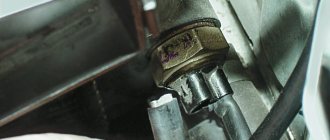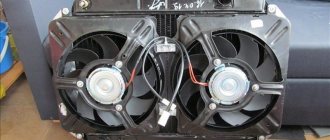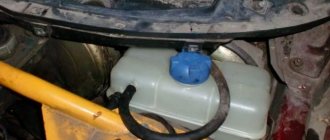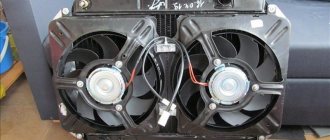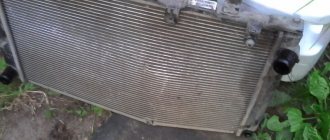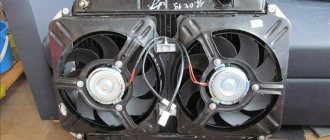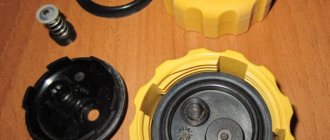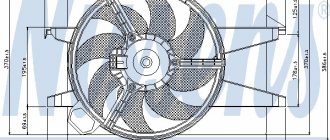As you know, during operation an internal combustion engine generates a large amount of heat. At the same time, it is important to maintain the temperature of the unit within specified limits for maximum efficient fuel combustion, reducing exhaust toxicity, increasing service life, etc.
In other words, you can’t both cool the engine too much and allow it to overheat. To maintain the required operating temperature, modern engines use a combined system that combines liquid and air cooling.
In the design of a liquid cooling system, an important element is the expansion tank. Next, we will talk about what the expansion tank of the engine cooling system is needed for, what its main purpose is, and what malfunctions of the expansion tank of the engine cooling system are most common.
What is an expansion tank?
Expansion tank - unit of the liquid cooling system of internal combustion engines; a specially designed container designed to compensate for leaks and thermal expansion of the coolant circulating in the system.
Expansion tanks are also used in other systems of vehicles, tractors and special equipment: in power steering (power steering) and in hydraulic systems for various purposes. In general, these tanks are similar in purpose and design to cooling system tanks, and their distinctive features are described below.
The expansion tank performs several functions:
The presence of a reservoir in a liquid cooling system is determined by the characteristics and physical properties of the coolant - water or antifreeze. As the temperature increases, the liquid, in accordance with its coefficient of thermal expansion, increases in volume, which also leads to an increase in pressure in the system. If the temperature rises excessively, the liquid (especially water) may boil - in this case, the excess pressure is released into the atmosphere through a steam valve built into the radiator cap. However, with subsequent cooling of the engine, the liquid acquires a normal volume, and since part of it was lost during the release of steam, the pressure in the system drops - if the pressure drops excessively, the air valve built into the radiator cap opens, the pressure in the system equalizes with atmospheric pressure. In this case, air enters the system, which can have a negative effect - air pockets form in the radiator tubes, preventing normal fluid circulation. So after releasing the steam, it is necessary to replenish the water or antifreeze level.
Antifreezes of various types have a higher coefficient of thermal expansion compared to water, so the processes described above occur more intensively. To eliminate these negative effects, an expansion tank connected to the radiator is introduced into the cooling system. As the temperature rises, excess fluid is simply drained into the tank, and when the engine cools, it is returned to the system. This significantly increases the threshold for steam release into the atmosphere and increases the interval between replenishment of the liquid level in the system.
The expansion tank plays an important role in the operation of the cooling system and the entire power unit, so in case of any malfunction it must be replaced. To select the right tank and carry out repairs correctly, you must first understand the existing types and features of these parts.
What causes the antifreeze level to decrease?
The coolant level is affected by a list of factors:
- integrity of the cylinder head, gaskets, block, radiator and hoses, heater and expansion tank;
- fixing all system hoses with clamps;
- full operation of valves;
- general condition of fluid drainage from the hose and neck;
- operation of the fuel supply system;
- correct setting of the ignition system;
- type of antifreeze;
- driving style.
We recommend: “S” mode on an automatic transmission: what you need to know
When cracks appear in the cylinder head or gaskets, antifreeze gradually leaks into the oil or cylinders. In the first case, the driver will receive a bubbly composition that is not suitable for further use in the system. In the second, the exhaust will take on the appearance of white steam even in warm weather. Punching the gasket is fraught with the appearance of two symptoms at the same time.
Additionally, there is a noticeable decrease in power output, which leads to increased gasoline consumption. Loosely secured hoses can leak antifreeze when high pressure in the system is reached. Failure of the radiator valves and expansion tank will prevent normal pressure from forming, which will lower the boiling point of the coolant and create the risk of vapor locks, which will greatly affect the integrity of the cylinder head.
Clogging of the exhaust hoses with slag may prevent the antifreeze from returning back to the radiator and engine. As a result, the acceptable level will drop, which will become the basis for the formation of new traffic jams.
Several factors also influence cylinder heating. And this is not only the operation of the cooling system, but also the competent adjustment of the fuel equipment itself, as well as the ignition system. If an over-lean mixture enters the system, detonation will occur, which can lead to faster combustion of gasoline with increased heat release. This leads to an increase in the temperature of the antifreeze, boiling and the appearance of traffic jams. As a result, we have a sharp drop in the coolant level and accelerated overheating of the engine.
If the fuel mixture is too rich, you will have to step on the gas harder to ensure proper power. In this case, the cylinders are overfilled with gasoline, which leads to a drop in the level of antifreeze and boiling of the system as a whole.
Glycerin coolants boil at a temperature of about 90-100 degrees . Even slight overheating of the engine is guaranteed to lead to the formation of steam. If the driver likes to drive in high gears with low revs (less than 2 thousand), then any climb or hill will cause an increase in the load on the powertrain and increase the temperature of the system. At such speeds, the pump is not able to provide adequate antifreeze. The cylinder head will begin to overheat, the fluid will begin to steam, and the level will slowly but surely decrease.
Design and features of expansion tanks
The expansion tanks used today have a fundamentally identical design, which is simple. This is a container with a volume of no more than 3 - 5 liters, the shape of which is optimized for placement in the engine compartment of a car. Currently, tanks made of translucent white plastic are most widespread, but metal products are also available on the market (usually for old domestic VAZ, GAZ and some trucks). The tank contains several elements:
Thus, any tank must have a filler neck with a plug and a fitting for connecting a hose from the main cooling radiator of the power unit. This hose is called a steam hose because hot coolant and steam are removed from the radiator through it. With this configuration, the fitting is located at the lowest point of the tank. This is the simplest solution, however, compensation for coolant leaks is carried out through the radiator, which in some cases reduces the efficiency of the cooling system.
In many tanks, a hose is additionally used to connect to the thermostat; in this case, the steam removal hose is connected to a fitting in the upper part of the tank (on one of its side walls), and the fitting for connecting to the heater radiator is in the same position. And the hose going to the thermostat comes out of the fitting at the bottom of the tank. This design ensures better filling of the cooling system with working fluid from the tank; overall, the system operates more efficiently and reliably.
Almost all modern expansion tanks use a liquid level sensor built into a neck specially designed for this purpose. Most often, this is a signaling device of the simplest design, which notifies about a critical decrease in the coolant level, but, unlike the fuel level sensor, does not inform about the current amount of liquid in the system. The sensor is connected to a corresponding indicator on the vehicle's dashboard.
The expansion tank plug, like the main radiator plug, has built-in valves: steam (high pressure) to relieve pressure when the coolant is overheated, and air to equalize the pressure in the system when it cools. These are ordinary spring valves that are activated when a certain pressure inside the tank is reached - when the pressure increases, the steam valve is released, and when the pressure decreases, the air valve is released. The valves can be located separately or combined into a single structure.
The tank is installed in the engine compartment near the radiator, connecting to it and other components through rubber hoses of various sections. The tank is slightly raised above the radiator (usually its center line coincides with the upper level of the radiator), which ensures free flow of liquid (by gravity) from the tank into the radiator and/or into the thermostat housing. The tank and radiator form a system of communicating vessels, so the fluid level in the radiator can also be assessed by the fluid level in the tank. For control, a scale or separate marks with the “Min” and “Max” indicators can be applied to the tank body.
Design and operation
The expansion tank consists of a polypropylene body, a cover and two pipes for connecting hoses of the liquid system. Using the lower hose, the device is connected to the cooling line, the upper one serves to remove vapors and air bubbles from the system. On modern models, float coolant level sensors are often installed.
For this option, the expansion tank is equipped with another neck on top, intended for installing a sensor. Several control marks are applied on the side surface of the container, from the bottom - min to the top - max. The coolant level should be located in this interval.
How does the device work? First, a little theory. The table shows the operating temperature conditions of modern engines. As we can see, the engines operate in critical temperature conditions.
| Engine temperature, °C | Working | Short term |
| 80 — 100 | 120 — 125 | |
| Boiling point of liquids, °C (at atmospheric pressure) | water | 100 |
| antifreeze | 105 — 110 | |
| antifreeze | 120 |
To raise the bar for permissible temperature, designers increase the pressure in the coolant (more than atmospheric), due to which its boiling point increases. To do this, the system is closed hermetically and excess pressure is maintained in it. For different engines, this value ranges from 0.1 to 0.5 bar (kg/cm²).
At the same time, significant vacuum (more than 0.03 - 0.1 kg/cm²) in the free space of the expander is unacceptable, since air will be sucked into the system, which will lead to the appearance of air pockets that impede coolant circulation and, consequently, to engine overheating . Maintaining the coolant pressure at the required level is the responsibility of a special regulator located in the filler cap.
Questions regarding the correct selection and replacement of the expansion tank
During vehicle operation, the expansion tank is exposed to high temperatures, significant pressure drops and aggressive environments (antifreeze, exhaust gases, fuel, oils, etc.) - all this can lead to damage to the tank and filler plug. The most common problems with plastic tanks are cracks in the body and ruptures due to excessive pressure build-up. In any of these cases, the tank must be replaced, and repairs must be made as soon as possible.
For replacement, you should only take a tank of the same type and catalog number that was installed on the car by the manufacturer - this is the only way to guarantee the correct operation of the entire system. If the plug also fails (which is usually indicated by a tank rupture due to a malfunction of the steam valve), then you need to buy that too. If the old plug works normally, then it can be installed on the new tank. The old liquid level indicator, as a rule, is also installed on the new tank without any problems.
Replacing the expansion tank must be carried out in accordance with the vehicle repair instructions. Usually, to perform this operation, you need to drain the antifreeze, disconnect all the hoses from the old tank, dismantle the tank (it is held in place by a clamp, sometimes with additional screws) and install the new part in the reverse order. In this case, it may be necessary to replace old clamps, so you should immediately take care of purchasing them. And if an old plug is installed, then it needs to be checked and, if necessary, cleaned.
After installation, it is necessary to fill in new antifreeze and close the plug; if you correctly select, replace and connect the new tank, the entire system will immediately begin to work normally, ensuring effective cooling of the power unit.
Source
Checking the functionality of the lid
Simplified test: are the valves working?
We start the engine and, being careful, unscrew the cap: if you hear the hissing sound of a deflated chamber, the bypass valve is working (however, whether it is correct or not is unknown).
After removing the cover, squeeze any hose of the cooling system with your hand. Continuing to hold it in this way, put the cover in place. If it then regains its shape, the vacuum appears to have been filled. But if, even before starting the engine, the hoses look like they are flattened, the vacuum valve is definitely not working.
More accurately, the safety valve can be checked using a pump and pressure gauge. We connect the pump to the lower supply pipe of the tank, and plug the upper one using improvised means: a bolt or a cylindrical drill that fits tightly into the supply hose.
We create pressure with the pump and control the moment when the safety valve is activated (hissing sound). The pressure value recorded on the device scale shows the actual response pressure.
If the safety valve is too tight, it can be repaired. Why spend extra money when it is enough to shorten the pressure spring by one or two turns, and the spring will become softer. The assembly is easy to disassemble, the main thing is not to lose small parts. And don't overdo it by biting off the coils. Do this little by little and check the results.
Everything about repairing and replacing the expansion tank in a car
The design of any car includes many different elements and mechanisms.
But the simplest and most reliable component on any make of car can be considered the coolant expansion tank.
However, its simplicity and durability is not a reason not to control the condition of the tank; in some cases, drivers have to carry out some repair work related to the restoration or even replacement of this product.
What is an expansion tank in a car
In the fuel supply system there is one inconspicuous and at the same time necessary element, which is called an expansion tank.
It serves to compensate for fluctuations in the volume of antifreeze (antifreeze) due to temperature changes.
According to its main function, the expansion tank is a container that serves as a reservoir for excess coolant in the system.
Antifreeze (or antifreeze) is a liquid made from a solution of propylene or ethylene glycol, so it has an increased percentage of expansion when heated.
It is this composition of liquids that allows for high-quality cooling of the engine, which is why antifreeze or antifreeze is poured into the cooling system.
That is, if this liquid is filled to the maximum, then when heated it will begin to expand and be squeezed out of the valves or hose joints.
After the engine cools down, the antifreeze will return to its normal volume. To prevent possible leakage of coolant, an expansion tank was installed.
Depending on the model of the car, the tank may have different shapes and volumes
Where is the expansion tank located in a car?
On all vehicle models, the expansion tank is installed in the engine compartment.
However, depending on the design features of a particular car, the tank can be attached to different parts of the body.
Most often, the expansion tank is installed in close proximity to the radiator, since it is the radiator that is responsible for cooling the liquids while driving.
The coolant reservoir is installed next to the radiator for ease of system operation
Design features
Expansion tanks for all car models are made of durable translucent plastic alloys.
There must be a division scale on the side of the product, which will allow you to monitor the volume of liquid in the system.
From a structural point of view, the expansion tank is the simplest element of any car.
It is a plastic container with a special sensor.
The tank is closed with a tight threaded lid, which ensures complete sealing of the cooling system.
The expansion tank consists of two elements - the body itself and the lid
Principle of operation
As the engine operates, the coolant begins to heat up.
Accordingly, antifreeze (antifreeze) expands, and the pressure in the system begins to increase.
At the moment when this pressure exceeds 120 kPa, the release valve on the tank opens.
If the pressure decreases and falls below 83 kPa, the valve closes.
Thus, excess coolant can always flow into the expansion tank, which eliminates damage to hoses, pipes and even the radiator itself.
When the engine finishes running, the coolant pressure in the system gradually drops.
When the 3 kPa mark is passed, the inlet valve on the tank opens, allowing air to enter it.
Fresh air quickly normalizes pressure, the amount of liquid in the tank is reduced.
There is always a different amount of coolant in the reservoir cavity during movement.
What affects the coolant level?
The engine is cooled thanks to a well-thought-out sealed system of tubes and channels through which antifreeze constantly circulates. Until the engine has warmed up to its operating temperature, the coolant is driven by the pump first in a small circle (stove, cylinder head, cylinder block). As soon as the antifreeze itself has warmed up to 90 degrees, the thermostat opens, starting a large circulation circle.
As the process progresses, the volume of liquid, based on the laws of physics, increases by 3-5%!, and all excess migrates to the expansion tank. When the power cools down, excess antifreeze again gets inside the engine. The process prevents the formation of vapor locks, which have a detrimental effect on the unit. This maintains the required level of coolant in the expansion tank. If the coolant level is critically low, the deficiency results in the appearance of steam or air plugs, which disrupts the temperature regime of the cylinder head. As a result, the head overheats, cracks, and the cooling and oil channels are destroyed. The overall compression and power are reduced, leading to increased fuel consumption and other problems, up to complete engine failure, which is fraught with major repairs.
Excess antifreeze causes an increase in pressure in the system, which leads to leaks in hoses and the cap of the expansion tank or radiator. Contact of cold coolant on a hot cylinder block will cause a sharp temperature drop. In rare cases, cracks may form. As a result, you begin to figure out how much antifreeze should be in the expansion tank.
We recommend: The principle of operation of the electric window and the causes of failure
Replacing the expansion tank with your own hands
Anyone can change the expansion tank on any car.
The procedure for performing the work is approximately the same for all brands and models:
Drain the liquid from the tank and pipes.
You need to place a container under the drainage area in advance so that antifreeze or antifreeze does not fall on the floor or ground. Do not forget that this liquid contains methyl alcohol, so the drainage area can be considered a fire hazard.
Disconnect the fastenings from the tank (usually they are made in the form of ties or clamps).
Remove the pipes from the tank.
Install a new expansion tank, connect the supply hoses to it, and secure them with new clamps for reliability.
Fill with new antifreeze/antifreeze.
Make sure that there are no leaks at the joints of the tank and pipes, and also that the same amount of liquid was filled in as was drained.
Video: the process of replacing the tank on VAZ cars
Thus, the driver can solve any problems with the expansion tank independently.
This product is not at all expensive, so in most cases, car enthusiasts prefer to buy new tanks rather than repair old ones.
Source
How to find out the type of coolant?
In order to find out exactly what is in your tank, you need the help of specialists. Namely, laboratory research, which will have chemical equipment in its arsenal.
If you buy a new car, then immediately rinse the tank and fill it with the antifreeze you need, so that you don’t have problems in the future and don’t wonder what kind of liquid it is. Replacing the coolant is inexpensive, but it will protect your car from overheating or engine frostbite. It will be much more expensive to replace the engine than the coolant.
Purpose of expansion tank
The cooling systems of various cars contain from 5 to 20 or more liters of non-freezing liquid - antifreeze (antifreeze). During operation, the engine, and along with it the antifreeze, heats up from low temperatures in winter to high temperatures in summer.
The temperature difference can reach 100 °C or more. For example, when operating a car in northern regions, where engine warm-up starts at minus 20 °C and ends at an operating temperature of 90 °C, this difference will be 110 °C.
During engine operation, a pressure of about 1 bar arises in the expansion tank
Since any liquid expands in volume when heated, excess is formed in the cooling circuit of the car, which needs to be directed somewhere. Antifreeze is an incompressible medium, so when it expands, it will create high pressure in the system, which can rupture the pipes and radiator honeycombs. Conversely, when cooled, the liquid will decrease in volume and create a vacuum (vacuum), which acts with the same force.
To ensure normal operation of the power unit cooling system and avoid pressure surges, an expansion tank is integrated into it. Its functions are as follows:
Large expansion tanks are used on trucks
Antifreeze, which is a mixture of distilled water with ethylene glycol (sometimes propylene glycol), adds about 5% in volume when heated from zero to 100 °C. In a circuit designed for 10 liters of antifreeze, after complete warming up, as much as 500 ml is formed, which goes into the expansion tank.
Video: why do you need an expansion tank?
Place of the reservoir in the cooling system
A container to compensate for expanding antifreeze can be installed in different places, the location depends on the make of the car. The reservoir is attached to body parts - side members and the interior partition using a rubber clamp or a special bracket. As a rule, the tank is placed on the side where the upper radiator pipe for its connection is located.
Typically the container is installed closer to the radiator pipe
There are containers with 2 and 3 fittings. The latter are connected by three hoses to the following units:
Excess antifreeze from three units enters the reservoir with 3 fittings.
The tanks, equipped with two fittings, are connected to the small circulation circuit and the main cooling radiator; there is no connection to the stove.
The expansion tank is the highest point of the engine cooling system. This is done so that the liquid from the tank can flow into the circuit according to the law of communicating vessels. When the antifreeze level in the container is 3-4 cm above the Min mark on the body, all pipes and units are filled with antifreeze. Including the highest of them - the throttle cooling circuit.
Remaining air from the system is removed through the throttle heating pipes
When pouring liquid into the water jacket of the power unit through the expansion tank, it is recommended to remove the throttle cooling pipe. This allows air pockets to be pushed out of the lines and the heater radiator.
Possible problems
Proper surface cleaning is the key to successful repairs. After a long period of use, the coolant in the reservoir is difficult to wash out. Motorists often use special cleaners, washing powder or citric acid solution.
In case of extensive contamination, the expansion tank is cleaned with fine gravel. The container is filled 15% with the dry ingredient, then filled with warm liquid and dishwashing detergent. The tank is gently shaken, trying to hit all the walls. The components are drained and the interior is washed with plenty of moisture.
Possible errors during repair Source drive2.com
“Atas Dimer” helps with traces of antifreeze. Concentrated alkaline substance copes with tough dirt. To operate, 15% of the liquid introduced into the container is sufficient. The expansion tank is shaken and left to work for 10 minutes. After time, the structure is filled 50% with warm water. The walls are cleaned with a long-handled brush. After the procedure, rinse thoroughly.
After gluing, the remaining fixing agent must be removed. The fresh mass is removed as it is released with a cloth. If the seam has already polymerized, then the defects will have to be cut off with a knife. Irregularities are smoothed out with fine sandpaper.
Liquids for filling into the tank
Today's cars, built with the widespread use of new technologies, are very demanding of all process fluids, including coolant. The list of requirements is as follows:
Antifreeze is a purely domestic product, synthesized during the USSR
All of the above requirements are met by antifreeze or antifreeze, which is the same thing. The name antifreeze comes from the English word antifreeze, which means “non-freezing”. Antifreeze is a substance created on the same basis from ethylene glycol in the former USSR. The word consists of the abbreviation TOS (technology of organic synthesis) and the ending “ol”, inherent in the names of chemical preparations.
The base of antifreeze and antifreeze is the same - water + ethylene glycol in different ratios. Differences between products from different manufacturers may lie in the package of inhibitory additives, so it is not advisable to confuse liquids. There will be no fatal consequences, but some substances can neutralize the effect of others and the anti-freeze properties will deteriorate. In this case, the color of the liquid does not matter - it is just a dye.
You can use distilled water to fill the tank in the following situations:
The color of antifreeze does not affect its properties; the additive package is important
Distilled (desalted) water does not meet the above requirements: it freezes at zero temperature and boils at 100 °C. Therefore, it is poured temporarily or as a solvent for antifreeze.
It is unacceptable to pour tap water saturated with salts into the expansion tank. An exception is the breakdown and loss of antifreeze on the way and the absence of a car shop nearby. Fix the leak, fill the cooling system with tap water and get to a garage or service station, then drain it immediately. Otherwise, deposits will form on the inner walls of the water jacket of the engine and other units, impairing heat transfer.
Video: liquids for pouring into the car cooling circuit
About malfunctions and tank repairs
During operation of the machine, the following breakdowns of the expansion tank may occur;
The tank wall ruptures when the internal pressure is too high
The leakage of the lid is characterized by the appearance of multi-colored streaks on the body
Most car enthusiasts, when a valve or body breaks down, simply replace the part with a new one. This is justified by the lack of time for repairs and the low cost of these spare parts. Although, if desired, the burst plastic of the tank can be soldered, and the lid can be disassembled and cleaned.
Leaks from under the cork occur when the seal is not tight or due to the design features of the container. For example, on VAZ 2110 cars, a stream from the upper small fitting connected to the radiator hits directly into the neck, causing a leak. The solution is to install a more advanced tank from Priora.
Troubleshooting methods
The leak in the plastic tank is repaired. In terms of durability, the design is inferior to new parts, although it will allow you to delay replacement. Let's look in detail at how to seal the expansion tank.
Sealing
Holes in plastic containers are eliminated using high temperature and reinforcing elements. During soldering, the polymer softens, acquiring the desired shape. The reinforcing structure increases the bond strength after hardening.
Soldering is considered a professional repair method. The procedure requires tools:
- soldering iron;
- metal scissors;
- a piece of fine mesh.

